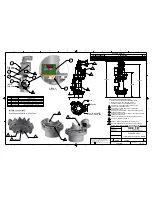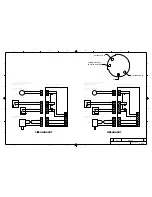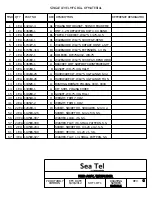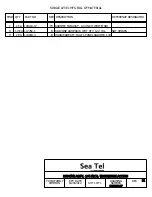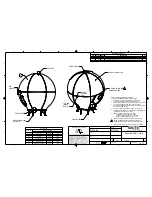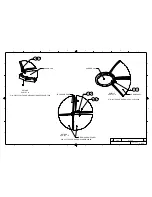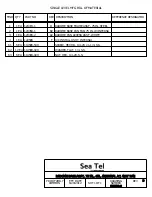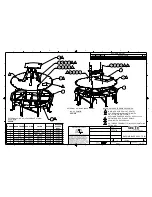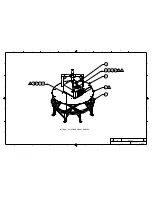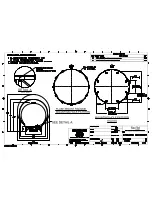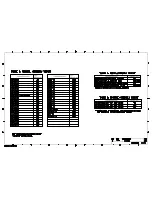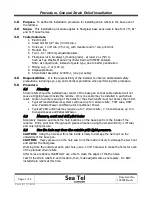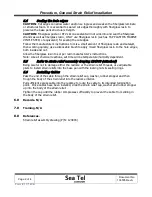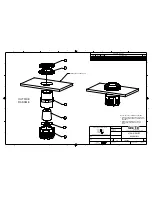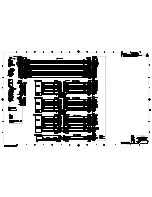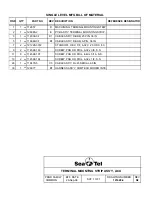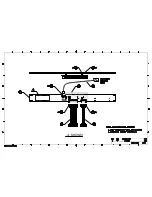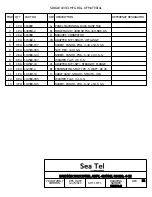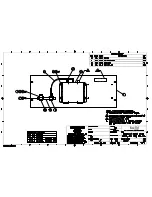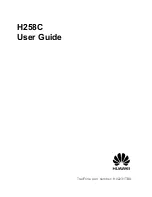
Procedure, General Strain Relief Installation
Page
1
of
4
Document No
136505 Rev A
Form # 117140-D
1.0
Purpose.
To define the installation procedure for installing strain reliefs in the base pan of
the radome.
2.0
Scope.
This installation procedure applies to fiberglass base pans used in Sea Tel’s 75”, 81”
and 110” base frames.
3.0
Tools/materials.
1.
Electric drill.
2.
Small drill bit 1/8” dia. (3-4mm dia.).
3.
Hole saw, 1 3/8” dia. (35 mm), with mandrel and ¼” dia. pilot drill.
4.
Medium file.
5.
Two 1-1/2” (38 mm) adjustable pliers.
6.
Fiberglass resin & catalyst, (marine grade) - at least 2 oz (50 cc).
Such as Tap Plastics Marine Vinyl Ester Resin with MEKP Catalyst.
Note: Use liquid resin, instead of paste type, due to better penetration.
7.
Mixing cup – 4 oz (100 cc).
8.
Disposable brush.
9.
Strain Relief Assembly 124903-1, (one per cable).
4.0
Responsibilities.
It is the responsibility of the installer to observe all standard safety
precautions, including eye, slip, and chemical protection when performing this procedure.
5.0
Procedure.
5.1
Planning
Strain reliefs should be installed near center of the base pan so that cable installed will not
cause a tripping hazard inside the radome. Only one cable may be installed in each strain
relief. Center-to-center spacing of the holes for the strain reliefs must not be less than 1.80”.
•
Typical Transmit/Receive systems will need up to 4 strain reliefs; TXIF coax, RXIF
coax, Pedestal Power and Marine Air Conditioner Power.
•
Typical TVRO antennas may require up to 7 strain reliefs; 2 C-band coaxes, up to 4
Ku-band coaxes and Pedestal Power.
5.2
Measure, mark and drill pilot holes
Accurately measure and mark the hole locations on the base pan from the inside of the
radome. Drill a pilot hole through each planned location using the small drill bit (~1/8” dia)
and only light pressure.
5.3
Use the hole saw from the outside w ith light pressure.
CAUTION:
Using the hole saw from the inside is likely to damage the Gel Coat on the
underside of the base pan.
CAUTION:
Heavy pressure on the hole saw from the inside is likely to damage the Gel Coat
and splinter the fiberglass.
Working from the outside at each pilot hole, use a 1-3/8” hole saw to make the holes for each
of the planned strain reliefs.
After holes are drilled, CAREFULLY use a file to clean the edges of the the holes.
Test fit the strain reliefs in each location, then, make adjustments as necessary. Do NOT
install strain reliefs at this time.
Summary of Contents for 9711QOR-86
Page 4: ......
Page 14: ...Table of Contents xiv This Page Intentionally Left Blank ...
Page 26: ...Site Survey 9711QOR 86 C Ku Band TXRX 2 8 This Page Intentionally Left Blank ...
Page 70: ...Installation 9711QOR 86 C Ku Band TXRX 3 44 This Page Intentionally Left Blank ...
Page 74: ...Basic Setup of the ACU 9711QOR 86 C Ku Band TXRX 4 4 This Page Intentionally Left Blank ...
Page 78: ...Setup Ships Gyro Compass 9711QOR 86 C Ku Band TXRX 6 2 This Page Intentionally Left Blank ...
Page 80: ...Setup Band Reflector Select 9711QOR 86 C Ku Band TXRX 7 2 This Page Intentionally Left Blank ...
Page 86: ...Setup Home Flag Offset 9711QOR 86 C Ku Band TXRX 9 4 This Page Intentionally Left Blank ...
Page 90: ...Setup Targeting 9711QOR 86 C Ku Band TXRX 10 4 This Page Intentionally Left Blank ...
Page 96: ...Setup Searching 9711QOR 86 C Ku Band TXRX 11 6 This Page Intentionally Left Blank ...
Page 122: ...Antenna Specific Operation 9711QOR 86 C Ku Band TXRX 16 12 This Page Intentionally Left Blank ...
Page 126: ...Functional Testing 9711QOR 86 C Ku Band TXRX 17 4 This Page Intentionally Left Blank ...
Page 190: ...Drawings 9711QOR 86 C Ku Band TXRX 23 2 This Page Intentionally Left Blank ...
Page 196: ......
Page 199: ......
Page 233: ......
Page 234: ......
Page 239: ......
Page 241: ......
Page 243: ......


